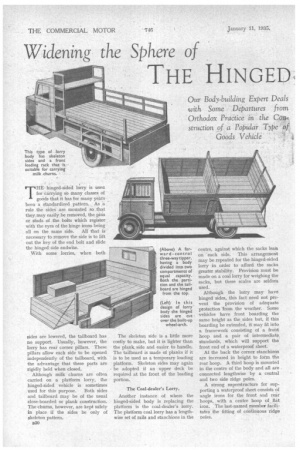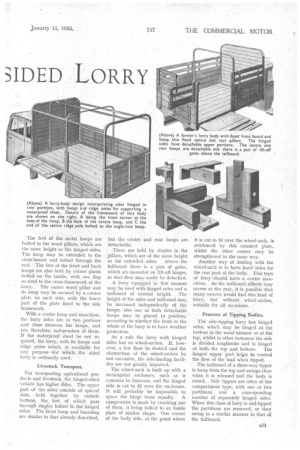Widening the Sphere of
Page 48

Page 49

If you've noticed an error in this article please click here to report it so we can fix it.
THE HINGED. SIDED LORRY
TIIE hinged-sided lorry is usea for carrying so many classes of goods that it has for many years been a standardized pattern.. As ,a. rule the sides are mounted so that they may easily be removed, the phis or studs of the bolts which register with the eyes of the hinge irons being
all on the same side. All that is necessary to remove the side is to lift out the key of the end bolt and slide the hinged side endwise. • With some lorries, when both sides are lowered, the tailboard has no support. Usually, however, the lorry has rear corner pillars. These pillars allow each side to be opened independently of the tailboard, with the advantage that these parts are rigidly held when closed.
Although milk churns are often carried on a platform lorry, the hinged-sided vehicle is sometimes
used for this purpose. Both sides and tailboard may be of the usual close-boarded or plank construction. The churns, however, are kept safely in place if the sides be only of skeleton pattern.
B30 The skeleton side is a little more costly to make, but it is lighter than the plank side and easier to handle. The tailboard is made of planks if it is to be used as a temporary loading platform. Skeleton sides may again be adopted if an upper deck be required at the front of the loading portion.
The Coal-dealer's Lorry.
Another instance of where the hinged-sided body is replacing the platform is the coal-dealer's lorry. The platform coal lorry has a lengthwise set of rails and stanchions in the
centre, against which the sacks lea'n on each side. This arrangement may be repeated for the hinged-sided lorry in order to afford the sacks greater stability. Provision must be made on a coal lorry for weighing the sacks, but these scales are seldom used.
Although the lorry may have hinged sides, this fact need not prevent the provision of adequate protection from the weather. Some vehicles have front boarding the same height as the sides but, if this boarding be extended, it may fit into a framework consisting of a front hoop and a pair of intermediate standards, which will support the front end of a waterproof sheet.
At the back the corner stanchions are increased in height to form the rear hoop. A third hoop is mounted in the centre of the body and all are connected lengthwise by a central and two side ridge poles.
A strong superstructure for supporting a waterproof sheet consists of angle irons for the front and rear hoops, with a centre hoop of flat iron. The last-named member facilitates the fitting of cOntinuous 'ridge poles.
The feet of the metal hoops are bolted to the wood pillars, which are the same height as the hinged-sides. The hoop may be extended to the cross-bearer and bolted through the end. The feet of the front and back hoops are also held by corner plates bolted on the inside, with one flap secured to the cross-framework of the lorry. The centre wood pillar and its hoop may be secured, by a corner plate on each side, with the lower part of the plate fixed to the side framework.
With a centre hoop and stanchion, the lorry sides are in two portions and close between the hoops, and are, therefore, independent of them. If the waterproof sheet be not required, the lorry, with its hoops and ridge poles intact, is available for any purpose for which the sided lorry is ordinarily used.
Livestock Transport.
For transporting agricultural products and livestock, the hinged-sided vehicle has higher sides. The upper part of the sides consists of spaced slats, .held together by outside battens, the feet of which pass through staples bolted to the hinged sides. The front hoop and boarding are similar to that already described, but the centre and rear hoops are detachable.
These are held by staples in the pillars, which are of the same height as the extended sides. Above the tailboard there is a pair of gates, which are mounted on lift-off hinges, so that they may easily be detached.
A lorry equipped in this manner may be used with hinged sides and a tailboard of normal height. , The height of the sides and tailboard may be increased independently of the hoops, also one or both detachable hoops may be placed in position, according to whether the front or the whole of the lorry is to have weather protection.
As a rule the lorry with hinged sides has no wheel-arches. If, however, a low floor be desired and the obstruction of the wheel-arches be nOt excessive, the side-loading facilities are not greatly impaired.
The wheel-arch is built up with a rectangular enclosure, such as is common in boxvans, and the hinged side is cut to fit over the enclosure. It will probably be impossible to space the hinge irons equally. A compromise is made by cranking, one of them, it being bolted to an inside plate of similar shape. One corner of the body side, at the point where it is cut to fit over the wheel-arch, is reinforced by this cranked plate, whilst the other corner may be strengthened in the same way.
Another way of dealing with the wheel-arch is to have fixed 'sides for the rear part of the body. This type of lorry -Should have a centre stanchion. As the tailboard affords easy access at the rear, it is possible that many owners would find this kind of lorry, but without wheel-arches, suitable for all occasions.
Features of Tipping Bodies, The side-tipping lorry has hinged sides, which may be hinged at the bottom in the usual manner or at the top, whilst in other instances the side is divided lengthwise and is hinged at both the top and bottom. The hinged upper part helps to control the flow of the load when tipped.
The tailboard of a three-way tipper is hung from the top and swings clear when it is released and the body is raised.. Side tippers are often of the compartment type, with one or two partitions and a corresponding number of separately hinged sides. When this class of lorry is end-tipped the partitions are removed, or they swing in a similar manner to that of the tailboard.




































































































